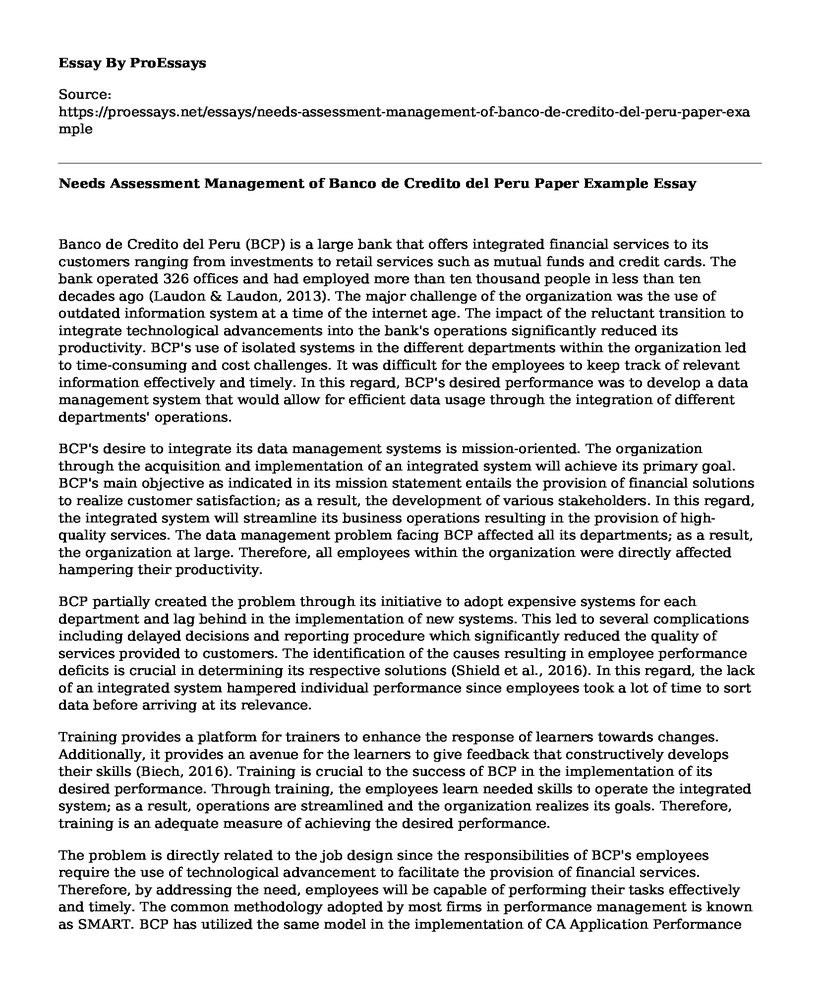Banco de Credito del Peru (BCP) is a large bank that offers integrated financial services to its customers ranging from investments to retail services such as mutual funds and credit cards. The bank operated 326 offices and had employed more than ten thousand people in less than ten decades ago (Laudon & Laudon, 2013). The major challenge of the organization was the use of outdated information system at a time of the internet age. The impact of the reluctant transition to integrate technological advancements into the bank's operations significantly reduced its productivity. BCP's use of isolated systems in the different departments within the organization led to time-consuming and cost challenges. It was difficult for the employees to keep track of relevant information effectively and timely. In this regard, BCP's desired performance was to develop a data management system that would allow for efficient data usage through the integration of different departments' operations.
BCP's desire to integrate its data management systems is mission-oriented. The organization through the acquisition and implementation of an integrated system will achieve its primary goal. BCP's main objective as indicated in its mission statement entails the provision of financial solutions to realize customer satisfaction; as a result, the development of various stakeholders. In this regard, the integrated system will streamline its business operations resulting in the provision of high-quality services. The data management problem facing BCP affected all its departments; as a result, the organization at large. Therefore, all employees within the organization were directly affected hampering their productivity.
BCP partially created the problem through its initiative to adopt expensive systems for each department and lag behind in the implementation of new systems. This led to several complications including delayed decisions and reporting procedure which significantly reduced the quality of services provided to customers. The identification of the causes resulting in employee performance deficits is crucial in determining its respective solutions (Shield et al., 2016). In this regard, the lack of an integrated system hampered individual performance since employees took a lot of time to sort data before arriving at its relevance.
Training provides a platform for trainers to enhance the response of learners towards changes. Additionally, it provides an avenue for the learners to give feedback that constructively develops their skills (Biech, 2016). Training is crucial to the success of BCP in the implementation of its desired performance. Through training, the employees learn needed skills to operate the integrated system; as a result, operations are streamlined and the organization realizes its goals. Therefore, training is an adequate measure of achieving the desired performance.
The problem is directly related to the job design since the responsibilities of BCP's employees require the use of technological advancement to facilitate the provision of financial services. Therefore, by addressing the need, employees will be capable of performing their tasks effectively and timely. The common methodology adopted by most firms in performance management is known as SMART. BCP has utilized the same model in the implementation of CA Application Performance Management to ensure its technological operations run efficiently (CA Technologies, 2016).
The CA Application Performance Management further addresses the initial problems of the bank by identifying any technological issue. As a result, the risk impacts on customers and other system users are significantly minimized. The performance model is appropriate for BCP since technologies adopted address the specific needs of the organization. Additionally, BCP'S performance framework is measurable since projected risks are measured by the CA Application Performance Management. Lastly, the technology is relevant and responds timely to the needs of BCP.
References
Biech, E. (2016). Change management training. Alexandria, VA: ATD Press.
CA Technologies. (2016). Banco de Credito del Peru Safeguards User Experience with Faster Troubleshooting with CA Technologies. Retrieved from https://www.ca.com/content/dam/ca/us/files/case-studies/banco-de-credito-del-peru-safeguards-user-experience-with-faster-troubleshooting-with-ca-technologies.pdf
Laudon, K., & Laudon, J. (2013). Essentials of Management Information System. New Jersey: Pearson Education Inc.
Shields, J., Brown, M., Kaine, S., Dolle-Samuel, C., North-Samardzic, A., McLean, P., Johns, R., O'Leary, P., Plimmer, G., & Robinson, J. (2016). Managing Employee Performance and Reward: Concepts, Practices, Strategies. UK: Cambridge University Press.
Cite this page
Needs Assessment Management of Banco de Credito del Peru Paper Example. (2022, Oct 19). Retrieved from https://proessays.net/essays/needs-assessment-management-of-banco-de-credito-del-peru-paper-example
If you are the original author of this essay and no longer wish to have it published on the ProEssays website, please click below to request its removal:
- Evaluating a Company's Budget Procedures
- Paper Example on Venturing into Retail Investment
- Essay on Impact of Leadership on the Implementation of a Current or Recent Development
- Essay Sample on Leadership Relationships
- Financial Report Analysis of Ma'aden Paper Example
- Essay on Evaluating Complex Clinical Decisions: Update Needed for Quality Measures
- Getting Out of Debt: How to Spend, Prioritize, and Have an Emergency Fund - Essay Sample







